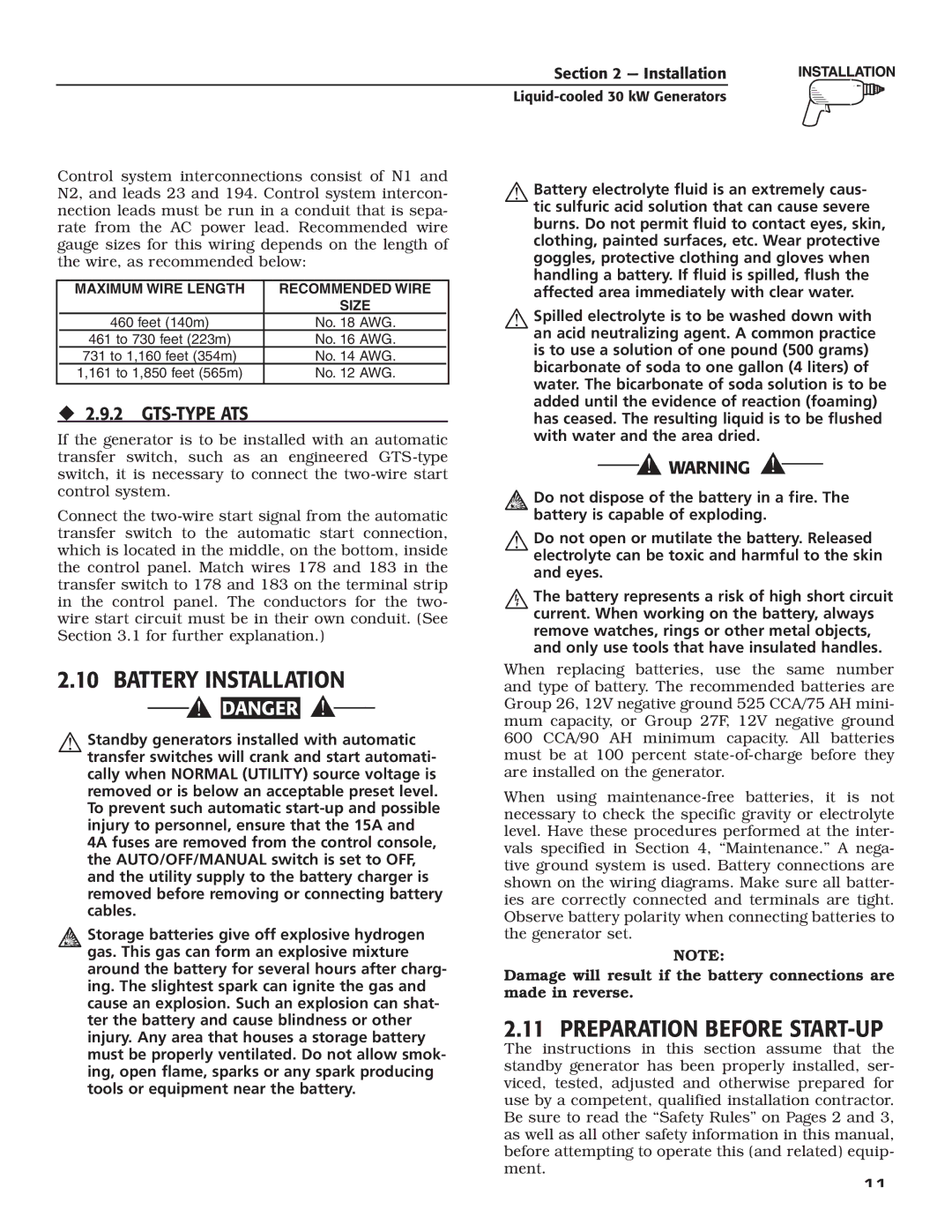
Section 2 — Installation
Control system interconnections consist of N1 and N2, and leads 23 and 194. Control system intercon- nection leads must be run in a conduit that is sepa- rate from the AC power lead. Recommended wire gauge sizes for this wiring depends on the length of the wire, as recommended below:
| MAXIMUM WIRE LENGTH | RECOMMENDED WIRE |
|
|
| SIZE |
|
| 460 feet (140m) | No. 18 AWG. |
|
| 461 to 730 feet (223m) | No. 16 AWG. |
|
| 731 to 1,160 feet (354m) | No. 14 AWG. |
|
| 1,161 to 1,850 feet (565m) | No. 12 AWG. |
|
|
|
|
|
2.9.2 GTS-TYPE ATS
If the generator is to be installed with an automatic transfer switch, such as an engineered
Connect the
Battery electrolyte fluid is an extremely caus- tic sulfuric acid solution that can cause severe burns. Do not permit fluid to contact eyes, skin, clothing, painted surfaces, etc. Wear protective goggles, protective clothing and gloves when handling a battery. If fluid is spilled, flush the affected area immediately with clear water.
Spilled electrolyte is to be washed down with an acid neutralizing agent. A common practice is to use a solution of one pound (500 grams) bicarbonate of soda to one gallon (4 liters) of water. The bicarbonate of soda solution is to be added until the evidence of reaction (foaming) has ceased. The resulting liquid is to be flushed with water and the area dried.
Do not dispose of the battery in a fire. The battery is capable of exploding.
Do not open or mutilate the battery. Released electrolyte can be toxic and harmful to the skin and eyes.
The battery represents a risk of high short circuit current. When working on the battery, always remove watches, rings or other metal objects, and only use tools that have insulated handles.
2.10BATTERY INSTALLATION
![]()
![]() DANGER
DANGER ![]()
Standby generators installed with automatic transfer switches will crank and start automati- cally when NORMAL (UTILITY) source voltage is removed or is below an acceptable preset level. To prevent such automatic
4A fuses are removed from the control console, the AUTO/OFF/MANUAL switch is set to OFF, and the utility supply to the battery charger is removed before removing or connecting battery cables.
Storage batteries give off explosive hydrogen gas. This gas can form an explosive mixture around the battery for several hours after charg- ing. The slightest spark can ignite the gas and cause an explosion. Such an explosion can shat- ter the battery and cause blindness or other injury. Any area that houses a storage battery must be properly ventilated. Do not allow smok- ing, open flame, sparks or any spark producing tools or equipment near the battery.
When replacing batteries, use the same number and type of battery. The recommended batteries are Group 26, 12V negative ground 525 CCA/75 AH mini- mum capacity, or Group 27F, 12V negative ground 600 CCA/90 AH minimum capacity. All batteries must be at 100 percent
When using
NOTE:
Damage will result if the battery connections are made in reverse.
2.11 PREPARATION BEFORE START-UP
The instructions in this section assume that the standby generator has been properly installed, ser- viced, tested, adjusted and otherwise prepared for use by a competent, qualified installation contractor. Be sure to read the “Safety Rules” on Pages 2 and 3, as well as all other safety information in this manual, before attempting to operate this (and related) equip- ment.
11
